Tested: 2022 Mercedes-Benz C300 4Matic Is One for Traditionalists
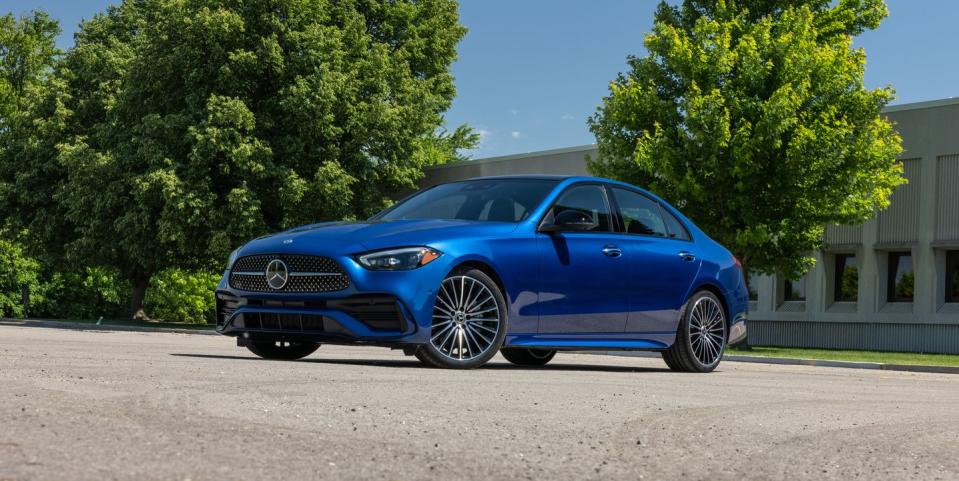
UPDATE 6/16/2022: This review has been updated with test results for a C300 4Matic model.
Like many automakers, Mercedes-Benz is rushing headlong into the electric future, with cars such as the EQS and the EQE. But that doesn't mean the brand is forsaking its familiar models. Case in point is the C-class sedan, which has been redesigned for 2022. The new C gets updated mechanicals and fresh tech features, yet it's also comfortably familiar in concept and appearance.
More than past generations, the latest C-class presents as a junior S-class. That starts with the new design's proportions. Mercedes describes the new C's design as "cab-backward," and the set-back passenger compartment draws a sharp contrast between this car and the lesser A-class (which is departing our market at the end of the model year) and CLA-class sedans, with their transverse-engine, front-drive architecture. The C-class also stands apart from the highly cab-forward, arc-shaped profile of the battery-powered EQE and EQS. Instead, the long hood and the stretched dash-to-axle ratio give the C-class a statelier appearance. This is despite smoother form language overall and a front-end design that adopts the wide, rounded grille shape that AMG models pioneered, now slightly canted forward. An AMG Line package, available across all trim levels, brings a resculpted lower fascia, rocker panel extensions, and a rear diffuser.
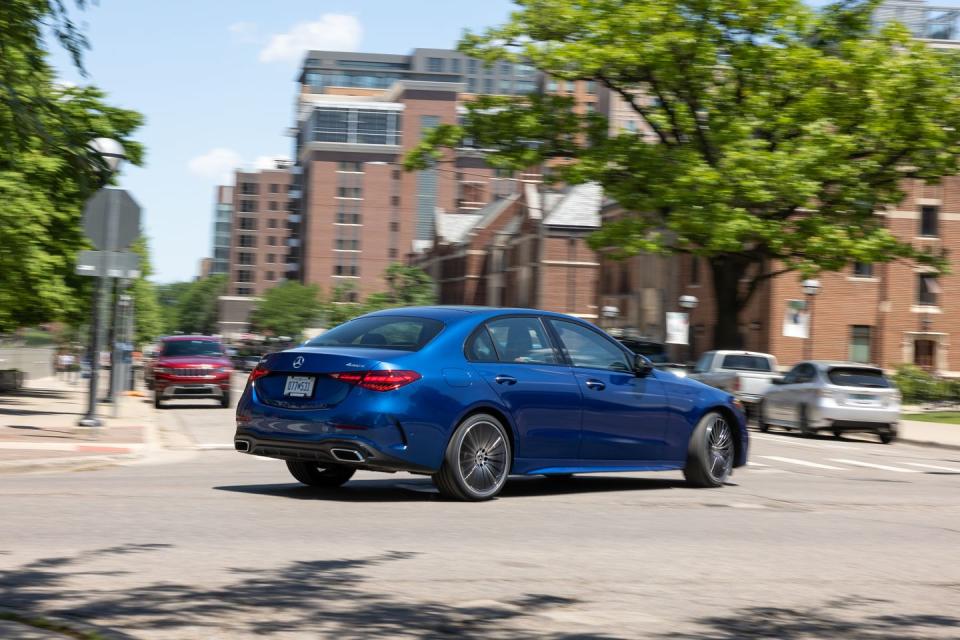
The car sits astride an inch-longer wheelbase but has grown 2.5 inches in length thanks to a longer rear overhang. Although overall width increases only fractionally, rear-wheel-drive models have a 1.9-inch-wider rear track that pushes the wheels out closer to the edge of the bodywork, while the front track increases by 0.8 inch. The track dimensions for the all-wheel-drive model aren't available yet.
As in the outgoing car, the C300 uses a turbocharged 2.0-liter four-cylinder. (A bigger change comes to the new-generation AMG C-class models, which switch to four-cylinder power as well for the C43 and even for the mighty C63.) For the first time, Mercedes is pairing a four-banger with a 48-volt hybrid-assist system, with the motor-generator integrated into the transmission housing. The electric motor cannot propel the car on battery power alone, but it does make for ultrasmooth auto stop/starts. It also enables engine-off coasting, but only under braking as the car nears a stop, which means you can silently creep up to your garage door.
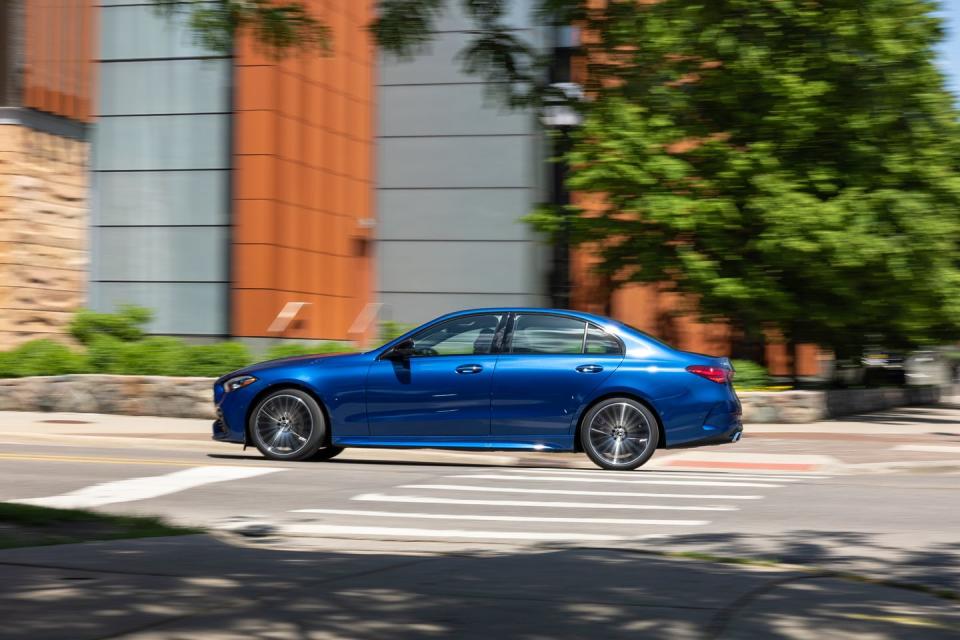
Rear-wheel drive is standard, and all-wheel drive is a $2000 upcharge on any trim level. Once again, the brand's 9G-Tronic nine-speed automatic handles shifting duties. The engine's stated horsepower is unchanged at 255, but torque swells from 273 to 295 pound-feet—plus, there's an additional 20 ponies and 148 pound-feet available in short bursts from the 48-volt starter-generator, though they do not add to the engine's total output. In our testing, the C300 4Matic hit 60 mph in 5.3 seconds—a respectable effort that is comparable to what the last BMW 330i xDrive we tested could manage, though not as quick as the 4.8 seconds it took an Audi A4 45 to reach that mark. The Benz's hybrid system effectively helps mask turbo lag at low speeds, and in passing maneuvers or highway merges, the powertrain zips the C-class ahead. As the tach needle approaches 5000 rpm or so, the formerly subdued engine emits a satisfyingly angry snarl, which is a bit of a surprise given that, when you're standing outside an idling C300, this engine clatters like a diesel.
EPA fuel-economy estimates for the new rear-drive C-class—25 mpg city, 35 mpg highway, and 29 mpg combined—are 1 to 2 mpg better than the outgoing model's but still short of the BMW 330i's 26/36 city/highway rating. With all-wheel drive, the figures drop by 2 mpg across the board. Our test car averaged a so-so 25 mpg, yet it posted a solid 35 mpg on our 75-mph highway test, beating its highway rating by 2 mpg.
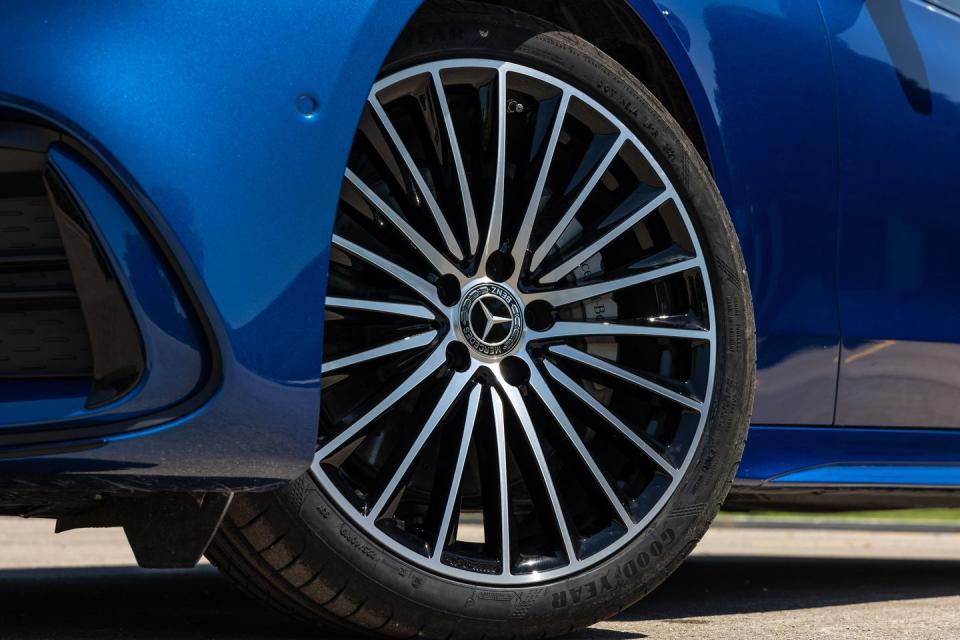
The chassis features adaptive dampers, but Mercedes Airmatic air springs are not offered in the new C-class. The AMG Line package includes a sport suspension with a 0.6-inch-lower ride height. The C-class offers Eco, Comfort, Sport, Individual, and (with the AMG Line) Sport+ drive settings, which have little discernible effect on the proceedings. In any mode, body motions are well controlled, but a fair degree of harshness is transmitted to the cabin. Evidently, it's hard for Stuttgart's chassis engineers to wrap their heads around the idea of a pothole-strewn infrastructure like we enjoy in the U.S. We'd lay some blame on staggered-fitment low-profile tires that wrapped the artful 19-inch wheels on our AMG Line sample car, but the situation was much the same in a different C300 that enjoyed slightly more sidewall—18-inch wheels and 225/45 front and 245/40 rear tires.
The AMG Line's meaty rubber delivered 0.91 g of stick on our skidpad in Michigan, although the C300 was eager to rotate with a lift of the throttle. They also helped the C-class hang tough on empty back roads in New York's Putnam County and across the Hudson in the foothills of the Catskill Mountains. Even when the road jogged away from us coming over a blind crest and we quickly jerked the wheel, or when we had to wind on more lock in response to tightening curves, turn-in was responsive with barely any push. Nor was there much in the way of body roll. The C300 would provide a sportier driving experience, though, if the steering weren't so inert. The brake pedal is also disconcertingly squishy, although stops from 70 mph took a tidy 154 feet.
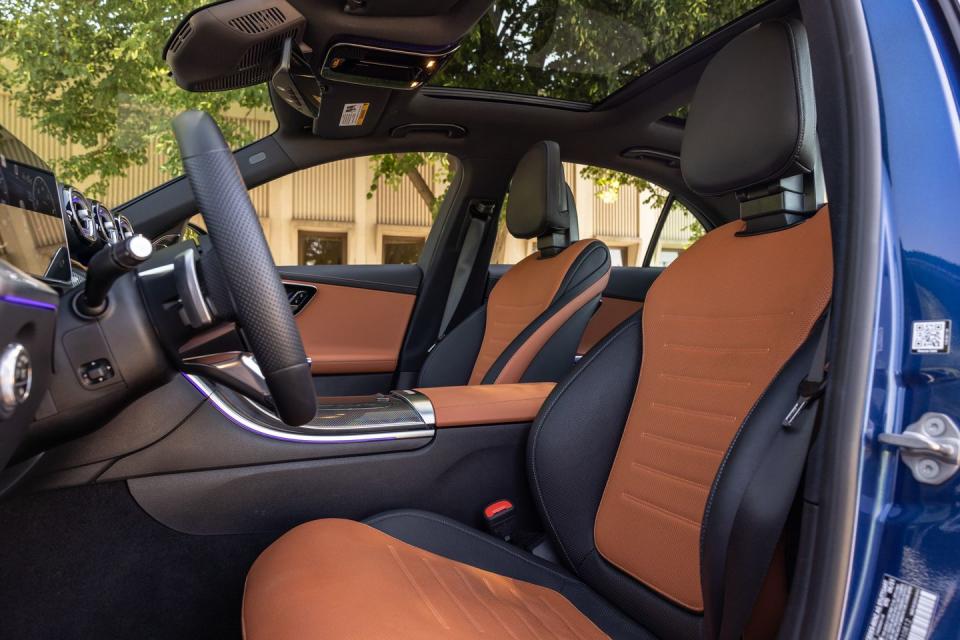
For the driver and passengers, the C-class cabin exudes S-class vibes, although it isn't quite as quiet inside: The 66 decibels we recorded at 70 mph are 2 decibels more than we detected inside a 2021 S580 model. The front chairs feel much like those in the senior Benz, with deep but not confining lateral bolsters, while the cushions, which can be lengthened or shortened, offer generous thigh support. The 12.3-inch digital instrumentation display and the new portrait-oriented 11.9-inch central touchscreen are free-standing. Behind them, the dash curves downward, waterfall-style. Black wood trim with vertical aluminum lines accentuates the shape, although other material choices are available. Continuing the theme of free-standing elements, the door handle and seat switches are contained in a pod that sits proud of the door panel, and the forward part of the door armrests appears to be floating. Bull's-eye air vents return but have been flattened at the top and bottom, and metal speaker grilles contribute to an atmosphere of calculated ostentation.
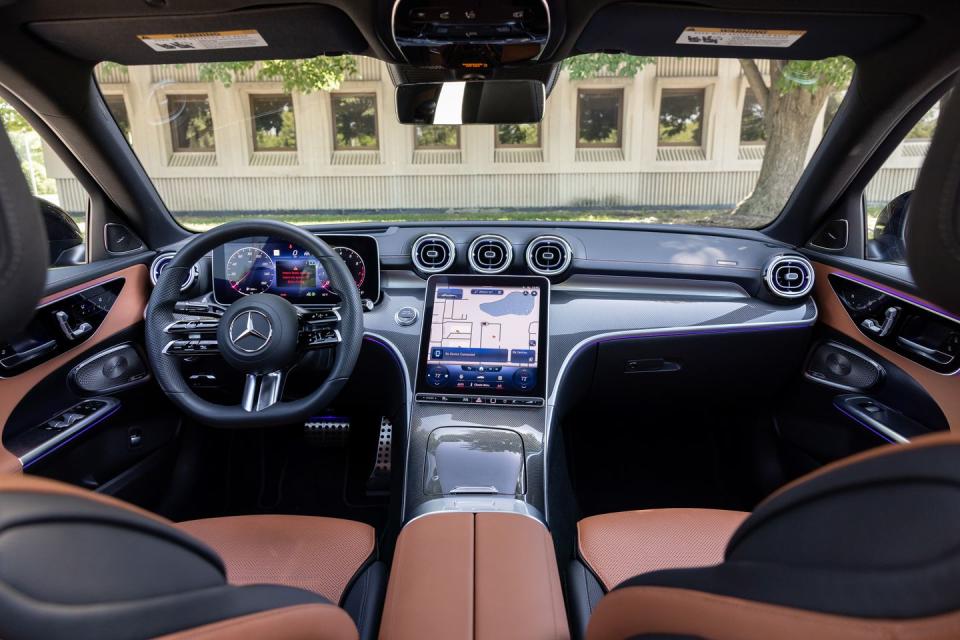
The navigation system now features augmented video, as in the S-class. When the car is approaching a turn, the display switches from the map to a forward-cam video feed overlaid with directional arrows and street names. The forward camera can also function as a dashcam.
The central touchscreen sweeps up from the center console, and the previous rotary controller is banished, as are all knobs and most buttons. At the base of the screen are a touch slider for audio volume (ugh) and touch-sensitive buttons to select the drive mode, call up the (excellent multiview) camera, and open the vehicle settings menu. There's also a fingerprint-recognition pad, which can be used to access personalized preferences. Climate controls are entirely onscreen, occupying the lower section of the display. Audio tuning is also onscreen. Wireless Android Auto and Apple CarPlay are standard, but wireless device charging costs extra; wired connections are USB-C only.
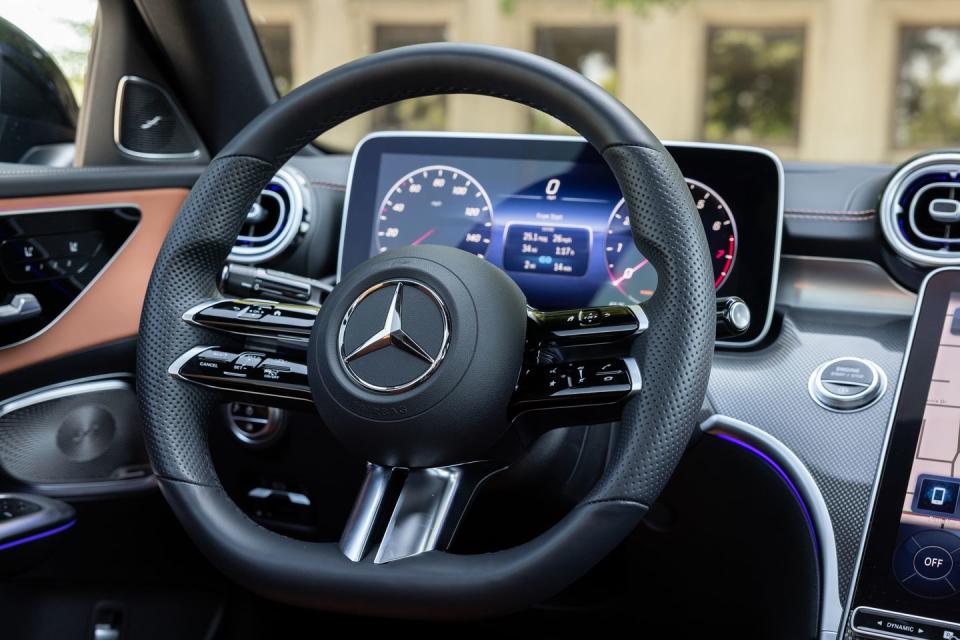
The controls on the steering wheel all are touch sensitive. They include a touch slider to raise and lower the cruise-control set speed and another for audio volume. Four-way swipe touchpads navigate the driver-information display or move around the central screen. Combine the imprecision of touch sliders with four-way touchpads that frequently give you a vertical-motion response when you're trying for a horizontal-motion action, and we just have to say: Enough with the touch madness already.
That modern annoyance aside, the C-class should appeal to those seeking a classic Benz at an attainable price. The C300 is offered in Premium, Exclusive, and Pinnacle trim levels, which are priced at $44,600, $46,850, and $48,550, respectively. Some expected luxuries cost extra, such as leather and adaptive cruise control with automated lane-change capability. But even at our all-wheel-drive Pinnacle test car's $63,590 as-tested price, the new C-class can seem like something of a bargain given how faithfully it emulates its six-figure sibling.

You Might Also Like

 Yahoo Autos
Yahoo Autos 